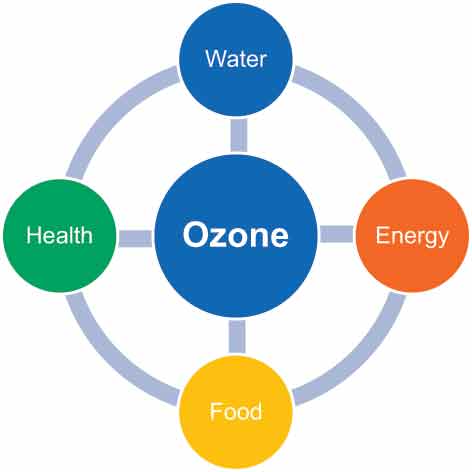 Selected papers presented at the International Ozone Association EA3G 2016 Conference on Ozone and Advanced Oxidation for the Water–Energy–Food–Health Nexus held at Swansea University, UK, in October 2016 are presented in this Special Issue of Ozone: Science & Engineering, Vol. 39 No. 5 (2017).
Selected papers presented at the International Ozone Association EA3G 2016 Conference on Ozone and Advanced Oxidation for the Water–Energy–Food–Health Nexus held at Swansea University, UK, in October 2016 are presented in this Special Issue of Ozone: Science & Engineering, Vol. 39 No. 5 (2017).
Ozone is a fascinating gas that has been successfully applied in the fields of water, energy, food, and health. Over a century, ozone has played a major role in drinking water treatment as being an effective oxidant with the objective to remove organic (e.g. pesticides) and inorganic substances (e.g. iron and manganese), disinfect the water and as a coagulant-aid. Despite being historically labeled as energy-intensive, ozone technology has improved significantly over the past decades, leading to important reduction in the energy demand for ozone production to values as low as 7-10 kWh/kg O3; there is still some margin for improvement. In wastewater, ozone is used to disinfect the wastewater, render it biodegradable and also to control odour emitted from the treatment plants. More recently, ozone and advanced oxidation have been on the rise to address the issue of emerging contaminants in wastewater (e.g. pharmaceuticals, antibiotics and endocrine disruptors). For example, a significant number of wastewater treatment plants in Switzerland are to be equipped with advanced treatment steps involving ozone as a preferential treatment technique for emerging contaminants. Beyond the water and wastewater sectors, ozone also has a place in the energy sector. As a strong oxidant and disinfectant, ozone has been applied in power stations to treat cooling water, control biofouling, and to treat dirty combustion exhaust gases. It has also been successfully applied as a pre-treatment step in bio-fuel production through enhancement of the feed biodegradation in anaerobic digesters and enzymatic hydrolysis processes. In nuclear power plants, ozone has the potential to decontaminate equipment and regenerate contaminated metallic wastes. Exploiting its antimicrobial and potent oxidation properties, ozone has been applied in almost all steps of food production ranging from grain preservation, enhancement of seed germination, water irrigation, anti-spoilage of post-harvest, increasing the shelf-life of produce, in poultry and dairy industries, and in meat preservation. In human health, ozone has been a controversial topic with opponents and supporters of the technology. However, a significant scientific volume of research studies is emerging; all evidencing the benefits of medical ozone when applied “properly”. The mechanisms by which ozone delivers its therapeutic effects are being better understood with upregulation of antioxidants being identified as a very important mechanism in ozone therapy. As part of its defence strategy, the immune system may naturally produce ozone. Medical ozone has been applied in the treatment of wounds, ulcers, viral diseases, treatment of burns and in dental medicine.
As the world population is growing fast (> nine billion by 2050) and becoming more prosperous, demands for water, energy, food and good health are pressing at a rate that has never been seen before. This is placing a significant pressure on these resources, which are already limited and not equitably distributed. A 70% increase in agricultural production is estimated to be needed to meet the demands by 2050 and 50% more primary energy will be needed by 2030. Water availability is essential for the production of energy and food, as well as for the health and wellbeing of the population, while energy is of huge significance in water and food production and health. A healthy population also means increased demands for water, energy and food. Water, energy, food and health are in fact inextricably interconnected and the interaction and trade-offs among these areas are complex. To solve the challenge of meeting the current and future generation demands of these essential resources, there is a need to take a holistic and integrated approach across the four domains; this is the nexus water-energy-food-health (WEFoH). As ozone and oxidation technologies make a significant impact on the four areas, they have an important role to play and be at the forefront to address the WEFoH nexus. It is important to shift our thinking towards the nexus concept which will involve addressing the challenges not in isolation but in a more integrated way whereby ozone and oxidation technologies are at the center of the solution.
and health are in fact inextricably interconnected and the interaction and trade-offs among these areas are complex. To solve the challenge of meeting the current and future generation demands of these essential resources, there is a need to take a holistic and integrated approach across the four domains; this is the nexus water-energy-food-health (WEFoH). As ozone and oxidation technologies make a significant impact on the four areas, they have an important role to play and be at the forefront to address the WEFoH nexus. It is important to shift our thinking towards the nexus concept which will involve addressing the challenges not in isolation but in a more integrated way whereby ozone and oxidation technologies are at the center of the solution.
